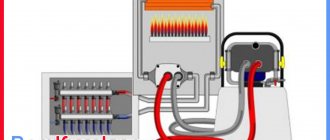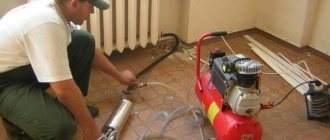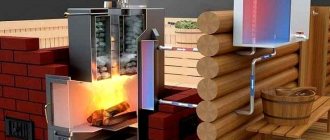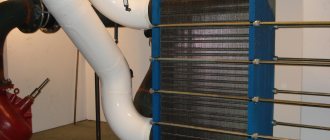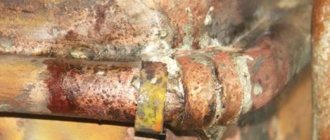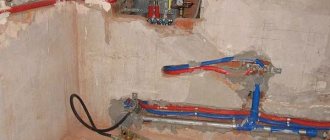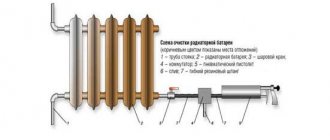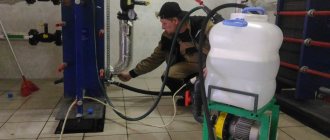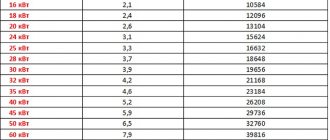Classification
Currently, manufacturers make heat exchangers from:
Steel heat exchanger
This is the most common option, especially when it comes to devices manufactured in domestic factories. It's all about the availability of steel and its easy processing. Hence the low cost of this device. Let us add that steel heat exchangers have excellent ductility and high strength when exposed to mechanical loads.
The plasticity of a material plays a major role when the metal is exposed to heat. In the zone of direct action of the burner, so-called thermal stresses are formed inside the metal, which can lead to the appearance of cracks. It is plasticity that prevents this from happening.
But steel heat exchangers also have their drawbacks.
- Firstly, steel is susceptible to metal corrosion processes. This shortens the service life. By the way, both the outer side of the device and the inner one begin to corrode.
- Secondly, in order to achieve a high degree of inertness, manufacturers increase the thickness of the heat exchanger wall and the size of its internal cavities. And this, in turn, increases its weight and size, plus fuel consumption for heating a large amount of coolant.
What are the features of combined gas-wood heating boilers?
But a cast iron heat exchanger practically does not corrode when in contact with water. Hence its long-term operation. But this metal imposes quite stringent requirements for the operation of gas equipment. The point is that the boundary between the highly heated and warm parts of the heat exchanger is a high-risk zone. This is where metal usually breaks.
To avoid this, it is necessary to flush the gas boiler heat exchanger more often. Thereby getting rid of deposits in the internal cavities of the device. There are zones inside the device where hot and warm water meet. This is the point where the coolant enters from the return circuit of the heating system. This is where so-called low-temperature corrosion occurs. Today this problem is solved by installing a three-way mixing valve. It is installed on the return line near the heat exchanger. The tap connects the heat exchanger, return and supply circuit. That is, hot water and cooled water are mixed inside. The coolant enters the heat exchanger at an acceptable temperature.
Attention! In this regard, imported gas boilers with a cast iron heat exchanger are very vulnerable. Cast iron is cast using the latest technologies, which allow the use of a structure with thin walls
But they are not adapted to Russian conditions.
There are many advantages of a copper heat exchanger:
- Low specific gravity.
- Small capacity of the device.
- Compact sizes.
- High resistance to corrosive processes.
- Less fuel is required for heating.
There are also disadvantages:
- High price.
- Low reliability when heating the element.

The last drawback is being resolved today. Manufacturers, using additional functional devices, strive to reduce the impact of thermal energy on metal. For example, by reducing the volume of internal cavities, you can reduce the gas supply and thereby reduce the size of the flame.
How to flush the heat exchanger of a double-circuit boiler
The method for removing scale from the DHW tract depends on the type of heat exchanger installed in your heat generator. There are only two of them:
- bithermal, it combines heating of the coolant and water for hot water supply;
- secondary heater made of stainless steel.
It is better to clean units of the first type using a booster, since removing such a unit can be quite difficult. Hoses leading from the tank are connected instead of cold water supply and hot water outlet, after which the circulation pump and the boiler itself start. The heating temperature should be limited to 50-55 degrees.

If there is a secondary heat exchanger in a double-circuit boiler, the latter can in most cases be removed. To do this, remove the front panel, and then unscrew the control unit and move it to the side. The secondary heat exchanger is located at the bottom and is secured with 2 bolts. After removal, it is immersed in a pan with citric acid dissolved in water and boiled on a gas stove, which is described in detail in the video:
Stages of dry cleaning:
- Special equipment introduces a chemical solution containing active reagents into the PHE. The substances destroy scale.
- Chemical substances remain and circulate inside the PHE for some time (according to the instructions of the product). At this time, deposits are destroyed.
- The PHE is washed (cleaned) with clean water. Water circulates inside the equipment for some time, just like a chemical agent. Then the liquid is removed.
- The above three steps are repeated until the outlet water becomes noticeably clean.
After completing cleaning of the PHE, it is important to check the equipment. The device must be tested to ensure its normal functioning:
- Measure the coolant pressure in the PHE;
- Check the possibility of leakage and the integrity of the device.
In order to avoid repair of the PHE and its failure, a check before starting must be mandatory.
Cleaning plate heat exchangers
The heat exchanger disconnected from the system should be cleaned from the outside and inside of any dirt, rust and scale that has formed. It will be most convenient to start cleaning the outer part.
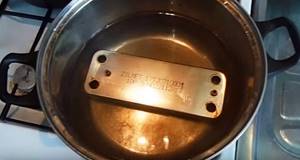
Having cleaned the outer surface, you can begin to tidy up the inside of the heat exchanger, that is, the inner walls of the curved pipe. There may be a fairly thick layer of scale in it, especially if previous maintenance was carried out a long time ago or not at all, or if the water in your home is quite hard. There may also be dirt inside that comes with tap water, especially if you do not have a filter installed to purify it.
How to clean soot from a boiler
Cleaning the boiler from soot
Although gas is a clean fuel, when it is burned, unburned heavy petroleum products are released, which are black layered films. This is soot, which adheres to the surface of the combustion chamber, to the heat exchanger, thereby reducing the thermal conductivity of metals. That is, soot is a barrier to heat penetration into the heat exchanger. This means that it is necessary to get rid of it, which is included in the cleaning procedure for gas boilers.
As with the heat exchanger, you can clean it yourself. As a rule, the internal surfaces of the firebox, external heat exchanger and chimney are cleaned.
Everything is simple with the firebox and heat exchanger. If the soot layer does not exceed 2 mm, then it can be removed with a scraper or a damp sponge. If the layer exceeds this figure, then chemical solutions cannot be avoided. For this, as in the case of the internal cavities of the heat exchanger, it is better to use acid-based solutions.
As for the chimney, this is the topic of a separate article. The only thing we can say is that there are quite a lot of ways to clean this pipe - after all, our ancestors did this for many centuries in a row, so they have accumulated colossal experience here.
Chemical washing
Cleaning the plate heat exchanger using chemical flushing (Figure 2) is used only in cases of low contamination of the PHE. For seriously contaminated equipment, cleaning must be carried out mechanically only.
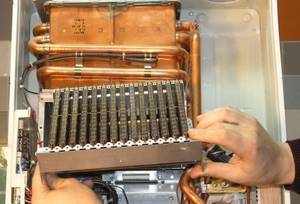
Rice. 3 Cleaning by mechanical disassembly method
Chemical reagents destroy and remove not very aggressive scale from the PHE. When purchasing a cleaning agent, you need to familiarize yourself with its composition and select the best option that matches the composition of the coolant.
The equipment is not disassembled before cleaning the plate heat exchanger. This is the difference between dry cleaning and mechanical cleaning and the savings. Special equipment is used to introduce chemicals into the PHE device, and also remove dirty water with loose scale.
